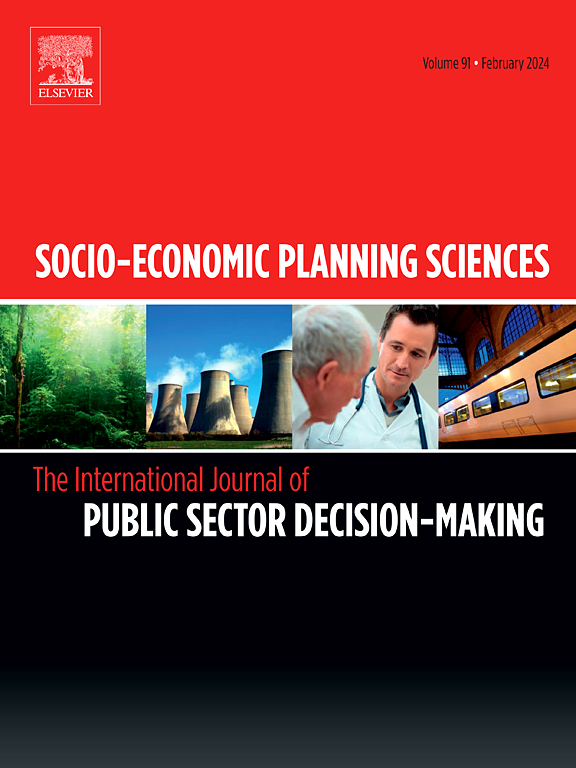碳交易、风险规避和政府补贴政策下可持续双通道供应链决策
IF 5.4
2区 经济学
Q1 ECONOMICS
引用次数: 0
摘要
在全球变暖、温室气体排放和环保意识增强的背景下,可持续供应链的决策变得至关重要,重点是将再制造纳入生态保护和资源利用。研究了需求不确定性和政府补贴下的绿色制造多层次可持续闭环供应链模型。首先,我们制定了一个闭环框架,包括绿色供应商、规避风险的上游制造商、规避风险的下游零售商和具有环保意识的收集商。其次,我们采取措施减少供应链中的碳排放,与更广泛的可持续发展目标保持一致。第三,研究了政府补贴对绿色制造活动的影响。市场需求对价格、交叉价格、绿色程度、碳排放水平和采集者的努力水平敏感。为了实现定价、绿化和努力决策,我们分析了一致性定价策略和不一致性定价策略下的CLSC模型。此外,为了实现最佳盈利能力,我们展示了制造商-零售商(MR),制造商-收集器(MC)和零售商-收集器(RC)下的供应链,包括分散的场景。分析结果表明,制造商-回收商联盟可以优化运输、储存和加工设施等资源的利用,具有更高的绿色水平和供应链盈利能力。数值说明还表明,不一致的定价策略使企业能够对需求和供应的变化做出反应,从而最大化收入潜力。此外,风险规避行为减少了不确定性,但对供应链的整体绩效产生了负面影响。最后,讨论了对有效参数的一些管理见解,以说明可持续性举措。本文章由计算机程序翻译,如有差异,请以英文原文为准。
Decision-making in sustainable dual-channel supply chain under carbon trading, risk aversion, and government subsidy policy
In the context of global warming, emissions of greenhouse gases, and growing environmental awareness, decision-making in sustainable supply chains becomes critical, focusing on incorporating re-manufacturing for ecological protection and resource utilization. This paper focuses on a multi-layer sustainable closed-loop supply chain model (SCLSC) under demand uncertainty and govt. subsidy in green manufacturing. Firstly, we formulate a closed-loop framework comprising a green supplier, risk-averse upstream manufacturer, risk-averse downstream retailer, and environmentally conscious collector. Secondly, we incorporate measures aimed at reducing carbon emissions within the supply chain that align with broader sustainability objectives. Thirdly, the influence of government subsidy in green manufacturing activities have been studied. Market demand is sensitive to price, cross-price, green degree, carbon emission levels, and the level of collector’s effort. To achieve the pricing, greening, and effort decision, we analyzed the CLSC model under i)consistency ii)inconsistency pricing strategy. Furthermore, to achieve the best profitability, we demonstrated the supply chain under manufacturer-retailer(MR), manufacturer-collector(MC), and retailer-collector(RC), including decentralized scenarios. The analytical results reveal that the manufacturer-collector coalition can optimize the utilization of resources such as transportation, storage, and processing facilities with higher green levels and supply chain profitability. The numerical illustration also reveals that the inconsistent pricing strategy enables businesses to respond to changes in demand and supply, maximizing revenue potential. In addition, risk-averse behavior reduces uncertainty but negatively impacts the overall performance of the supply chain. Finally, some managerial insights into effective parameters have been discussed to illustrate the sustainability initiatives.
求助全文
通过发布文献求助,成功后即可免费获取论文全文。
去求助
来源期刊

Socio-economic Planning Sciences
OPERATIONS RESEARCH & MANAGEMENT SCIENCE-
CiteScore
9.40
自引率
13.10%
发文量
294
审稿时长
58 days
期刊介绍:
Studies directed toward the more effective utilization of existing resources, e.g. mathematical programming models of health care delivery systems with relevance to more effective program design; systems analysis of fire outbreaks and its relevance to the location of fire stations; statistical analysis of the efficiency of a developing country economy or industry.
Studies relating to the interaction of various segments of society and technology, e.g. the effects of government health policies on the utilization and design of hospital facilities; the relationship between housing density and the demands on public transportation or other service facilities: patterns and implications of urban development and air or water pollution.
Studies devoted to the anticipations of and response to future needs for social, health and other human services, e.g. the relationship between industrial growth and the development of educational resources in affected areas; investigation of future demands for material and child health resources in a developing country; design of effective recycling in an urban setting.
 求助内容:
求助内容: 应助结果提醒方式:
应助结果提醒方式:


